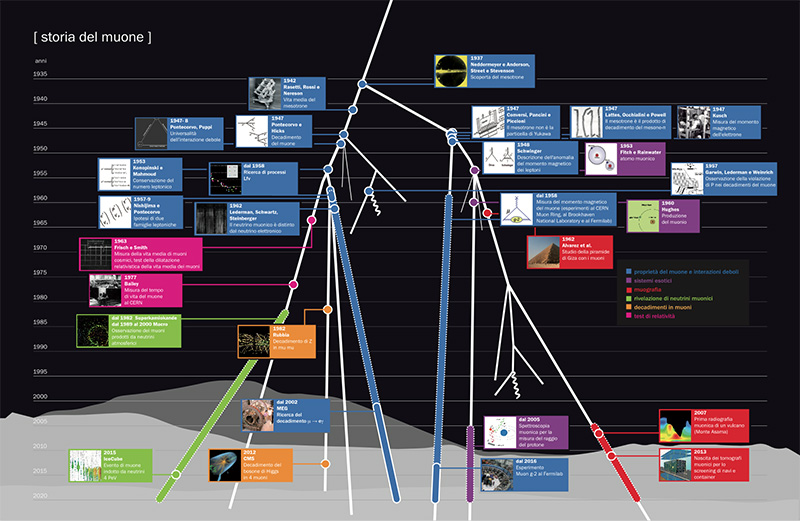History of the most elegant, eclectic and solid particle
By Filippo Ceradini
 In the mid ‘30s electron, positron, proton, neutron were known and the existence of neutrinos had been hypothesized. It was a time of great cultural turmoil and technological progress. The first theories of particle interactions had been formulated: the theory of β decay (see fig. d) by Enrico Fermi in 1934, the theory of “nuclear forces” by Hideki Yukawa in 1935, the quantum theory of electromagnetic radiation by several scientists, inter alia Paul Dirac, Werner Heisenberg, Wolfgang Pauli, Viktor Weisskopf and Walter Heitler (the latter had proposed this theory in his famous treatise of 1936). Experimental physicists had developed some techniques to detect ionizing particles with the Wilson cloud chamber and the Geiger–Müller counter and these instruments were used to study the particles produced in cosmic rays interactions in the atmosphere. Experiments were mostly performed in high mountain: at Pike’s Peak (Rocky Mountains), Pic du Midi (Pyrenees) and Plateau Rosa (Alps). In 1932, while studying traces in the cloud chamber, Carl Anderson and Seth Neddermeyer observed a particle which couldn’t be identified as neither a proton, nor an electron. Unlike electrons, this new particle released clearer and more defined traces and didn’t seem to lose energy along the way. The following year, Jabez Street and Edward Stevenson proved this particle had a mass that was intermediate between those of an electron and a proton. For this reason it was called “mesotron” or simply “meson” (from the Greek mesos meaning “in the middle”). As it was going to be clear about ten years later, the particle we nowadays call “muon” had been discovered: the most elegant, eclectic and penetrating of all particles. More accurate measurements enabled to define its characteristics: a mass about 200 times the electron’s one and an electric charge which is both positive and negative. Furthermore, it was observed that positive mesotrons decayed into positrons, with a continuous energy spectrum, a typical characteristic of nuclei β decay. To measure their average life was more difficult.
In the mid ‘30s electron, positron, proton, neutron were known and the existence of neutrinos had been hypothesized. It was a time of great cultural turmoil and technological progress. The first theories of particle interactions had been formulated: the theory of β decay (see fig. d) by Enrico Fermi in 1934, the theory of “nuclear forces” by Hideki Yukawa in 1935, the quantum theory of electromagnetic radiation by several scientists, inter alia Paul Dirac, Werner Heisenberg, Wolfgang Pauli, Viktor Weisskopf and Walter Heitler (the latter had proposed this theory in his famous treatise of 1936). Experimental physicists had developed some techniques to detect ionizing particles with the Wilson cloud chamber and the Geiger–Müller counter and these instruments were used to study the particles produced in cosmic rays interactions in the atmosphere. Experiments were mostly performed in high mountain: at Pike’s Peak (Rocky Mountains), Pic du Midi (Pyrenees) and Plateau Rosa (Alps). In 1932, while studying traces in the cloud chamber, Carl Anderson and Seth Neddermeyer observed a particle which couldn’t be identified as neither a proton, nor an electron. Unlike electrons, this new particle released clearer and more defined traces and didn’t seem to lose energy along the way. The following year, Jabez Street and Edward Stevenson proved this particle had a mass that was intermediate between those of an electron and a proton. For this reason it was called “mesotron” or simply “meson” (from the Greek mesos meaning “in the middle”). As it was going to be clear about ten years later, the particle we nowadays call “muon” had been discovered: the most elegant, eclectic and penetrating of all particles. More accurate measurements enabled to define its characteristics: a mass about 200 times the electron’s one and an electric charge which is both positive and negative. Furthermore, it was observed that positive mesotrons decayed into positrons, with a continuous energy spectrum, a typical characteristic of nuclei β decay. To measure their average life was more difficult.
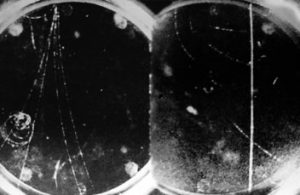 a.
a.
Pictures of traces observed in a Wilson cloud chamber, with a diameter of about 30 centimeters. On the left, a swarm of positrons and electrons; on the right, a single ionizing particle.
In those days, there were no detectors with good temporal resolution: to determine mesotrons’ average life they used to compare flux measurements of these particles performed in high mountain laboratories with those performed at sea level. The first results were contrasting because of the different behaviour of negative mesotrons and the positive ones (the former can be captured by nuclei; the latter decay in flight). The problem was solved by Bruno Rossi that – since 1930 – had developed new electronic circuits which enabled to perform temporal coincidence among signals produced by the various detectors used in the experiment. In 1941, Franco Rasetti and, independently Bruno Rossi and Norris Nereson, using the new circuits coupled with Geiger-Müller counters, measured the average life of these particles obtaining a value of 2,2 microseconds. This measurement provided also the first direct proof of the relativistic theory of time dilation: in fact, travelling at the speed of light, mesotrons would cover less than 700 meters before decaying and couldn’t reach us after being produced in the upper atmosphere. The reason why we can observe a plenty of them at sea level is that their average life in a laboratory system (where they travel at a velocity close to the speed of light) is significantly dilated compared to the 2,2 microseconds average life in their rest system. Until the early ‘40s the mesotron was considered the mediator particle between nuclear forces imagined by Yukawa in 1935. His theory predicted the constituents of the atomic nucleus, protons and neutrons, interacted and were bound through the exchange of particles with a mass of the order of a few hundred electronic masses, a characteristic in common with the mesotron.
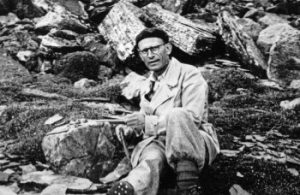 b.
b.
Franco Rasetti, in a picture taken in 1941. In the ’30s Rasetti was part of the famous group of “the boys of via Panisperna”.
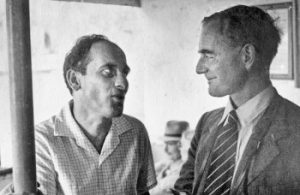
c.
Giuseppe Occhialini (on the left) and Cecil Powell (on the right).
The identification of the mesotron with the Yukawa particle seemed natural, but it was retracted with the experiment by the three young Italian researchers, Marcello Conversi, Ettore Pancini and Oreste Piccioni that – during the World War II – carried out researches about cosmic rays at the then new Physics Institute of Roma La Sapienza University and, after the bombing of San Lorenzo, moved the apparatus into Virgilio High School. Conversi, Pancini and Piccioni used an innovative experimental method which included Geiger-Müller counters, coincidence circuits and magnetic analyzers (the magnetic lenses developed by Gilberto Bernardini): a modern spectrometer. The coincidences of the counters and the magnetic lenses enabled to distinguish the decays of positive mesotrons from those of the negative ones. Mesotrons were made impinge upon materials called “absorbers” with a very different atomic number, such as carbon or iron, in which they decayed. The analysis of measurements of the various phenomena and decay of positive and negative mesotrons showed the mesotron wasn’t affected by the nuclear force and so it couldn’t be the Yukawa particle. Its nature was cleared shortly after, observing the traces of a “mother” particle, with a mass slightly bigger, which decays into a mesotron and into another invisible neutral particle (then identified as neutrino). This observation was made by Cecil Powell, César Lattes and Giuseppe Occhialini, using photo emulsion sheets with a high sensitivity developed in collaboration with Ilford company. The mother particle was called π-meson, while the “daughter” particle (the “old” mesotron”) was named μ-meson. Then it was clear the π was actually the Yukawa particle. The μ, soon renamed “muon”, was instead a new particle, unexpected from a theoretical point of view. Today we know the μ is an elementary particle, belonging to the “leptons” category (from the Greek leptos, light). Therefore the muon lost its “meson” definition, a name given to a category of hadrons (particles which are affected by the strong force, the fundamental force at the basis of all nuclear forces), made of a quark and an anti-quark. The π (more commonly known as “pion”), on the contrary, is a true “meson”, with a 140 MeV mass (that is 274 times the mass of the electron).
Right after the discovery by Lattes, Occhialini and Powell, the Italian physicists Bruno Pontecorvo and Giampietro Puppi, analyzing the neutron β decay, the muon decay into an electron and the capture of the muon by a neutron (see fig. d), concluded that all these processes were due to the same interaction, the weak force described in Fermi’s theory. This is the most peculiar among the fundamental forces, the one allowing the higher number of transgressions. The original theory by Fermi, extended to quarks by the Cabibbo-Kobayashi-Maskawa theory, contains just one fundamental parameter: the “Fermi universal constant”, precisely determined by both the average life and the mass of the muon. The muon mass is obtained with great precision from the energy levels of the muon-electron atom (μ+e–, called “muonium”), and it’s 106 MeV (207 times the electron mass). Then the muon average life was measured with increasing precision using intense beams of muons and its present value is 2,197 microseconds: as a result, Fermi universal constant is currently known with the precision of one part per million. And that is just thanks to the muon. The only muon decay we know is into an electron, a neutrino and an anti-neutrino. For a long time other decays were sought. The first attempt dates to 1948, when Ted Hincks and Bruno Pontecorvo searched for the decay of a muon into an electron and a photon, without success. In 1953 Emil Konopinski and Hormoz Mahmoud introduced the concept of “lepton number”, as quantity conserved in the weak interaction. The idea was that the electron, the negative muon and the neutrino had a lepton number of +1, while the positron, the positive muon and the antineutrino -1. In the muon decay, indeed, the lepton number is conserved, assuming a neutrino and an antineutrino are emitted. In the late ’50s, from the work of Kazuhiko Nishijima and Bruno Pontecorvo, it emerged the idea of lepton “families” and two kinds of neutrino: the electronic neutrino and the muonic one. The electron and the corresponding neutrino, and the muon with its neutrino constitute two different lepton families, each one has its own lepton number conserved. Instead, the decay into an electron and a photon is prohibited because it violates the muonic and electronic lepton number conservation law.
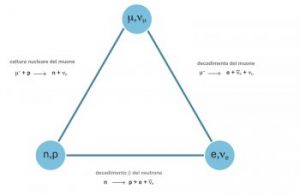 d.
d.
The so-called “Puppi triangle”, showing the fact that the three different processes (β decay, muon decay and muon capture) have the same coupling constant in common, since they derive from the same universal interaction, the weak force.
This implies that the neutrino and the antineutrino produced from the muon decay belong to different families. To verify this hypothesis, Pontecorvo and, independently, Melvin Schwartz suggested using beams of neutrinos produced from the decay of pions into muons. Using the most powerful accelerator at that time, the Ags of Brookhaven, in 1962 Leon Lederman, Jack Steinberger and Melvin Schwartz proved that neutrinos obtained from the Ags beam, in the interaction with an aluminum target, produced muons, but not electrons: so they were muonic neutrinos. As a consequence the existence of two lepton families was confirmed. Later it was added a third family, that of the τ-lepton, discovered by the group of Martin Perl in 1975. Muon decays violating the lepton number conservation were extensively sought, until we’ve reached an upper limit of one out of a million million on prohibited decays. The muon has always forcefully defended its identity and the one of its family being distinct from the other. Between ‘50s and ‘70s the muon was protagonist in several measurements that brought important results. In 1953 Val Fitch and James Rainwater introduced a new method to measure the radius of the nuclei based on the formation of muonic atoms. If a nucleus captures a negative muon, the latter orbits around the nucleus at a distance which is much shorter than the electrons’ and the X-rays emitted by this exotic atom are much more clearly affected by the nucleus dimensions.
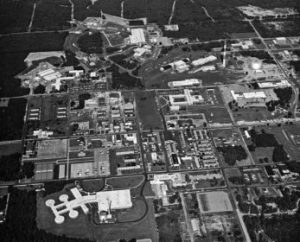 e.
e.
A bird’s-eye view of Brookhaven Laboratory around 1963. In the upper middle part of the photo you can see the Alternating Gradient Synchrotron (Ags).
With this method, in the following years, the radius of various nuclei were measured in a systematic manner. Increasing the precision, in recent times, a quite surprising result was obtained: the proton radius measured in muonic hydrogen differs from the one measured by other methods! Today we call it the proton radius puzzle: it fascinates researchers and encouraged new tests. Another very relevant result was the proof of “parity” violation in the weak interaction. In 1956 two young theoretical physicists, Tsung-Dao Lee and Chen-Ning Yang, in order to explain the strange behavior of some particles, proposed that weak interactions, responsible for β decay of nuclei and muon decay, were not invariant for parity transformations, in other words they distinguished left from right. The muon, like the electron, has a spin which produces a magnetic dipole and the latter can have two different orientations in the motion direction: right-handed or left-handed. Yang and Lee’s idea was that all fermions could behave differently according to these two orientations. This hypothesis can be verified studying the muon decay into an electron. A few months after their theoretical proposal, Richard Garwin, Leon Lederman and Marcel Weinrich measured the direction of the electrons produced in the muons’ decay of which we know the spin orientation. Lee and Yang’s hypothesis was confirmed and, in addition, Garwin, Lederman and Weinrich had a lucky guess: they made the muon magnetic dipole rotate and observed that the electron direction followed that of the muon spin. Hereafter, a long series of experiments to evaluate the so-called “magnetic momentum of the muon” started. Increasingly precise experiments, performed trapping positive or negative muons within a “magnetic ring”, proved the muon’s magnetic momentum has a different value from the one predicted by theoretical calculation of quantum electrodynamics. Measurements and calculations reached a precision of a part per million and – in order to clarify the origin of the so-called muon g-2 puzzle – measurements and calculations reaching higher precision are in progress. Lastly, muons are present in the final states of many subnuclear processes, which made them important protagonists in the discovery of various particles. W and Z bosons, weak interaction mediators, for example, were first observed in the muon decay during the UA1 collaboration at Cern, led by Carlo Rubbia. In 2012 the same Higgs boson proved its own existence decomposing itself in photons but also in a final state with four muons. “Who ordered that?”, said about the muon the great physicist Isidor Rabi, when the nature of this new particle was clear, a particle which didn’t seem to respond to any theoretical need. Seventy years later, seeing the muons wealth in terms of physics and knowledge about the subnuclear world it provided, we can only be pleased with its existence.
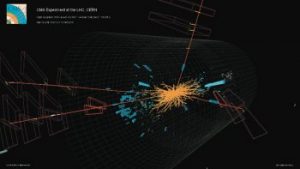 f.
f.
Display of an event of production of a Z bosons couple, in the Higgs boson decay, in which we can observe four muons (the red lines).
Translation by Camilla Paola Maglione, Communications Office INFN-LNF
 INFN-LNF Laboratori Nazionali di Frascati
INFN-LNF Laboratori Nazionali di Frascati
